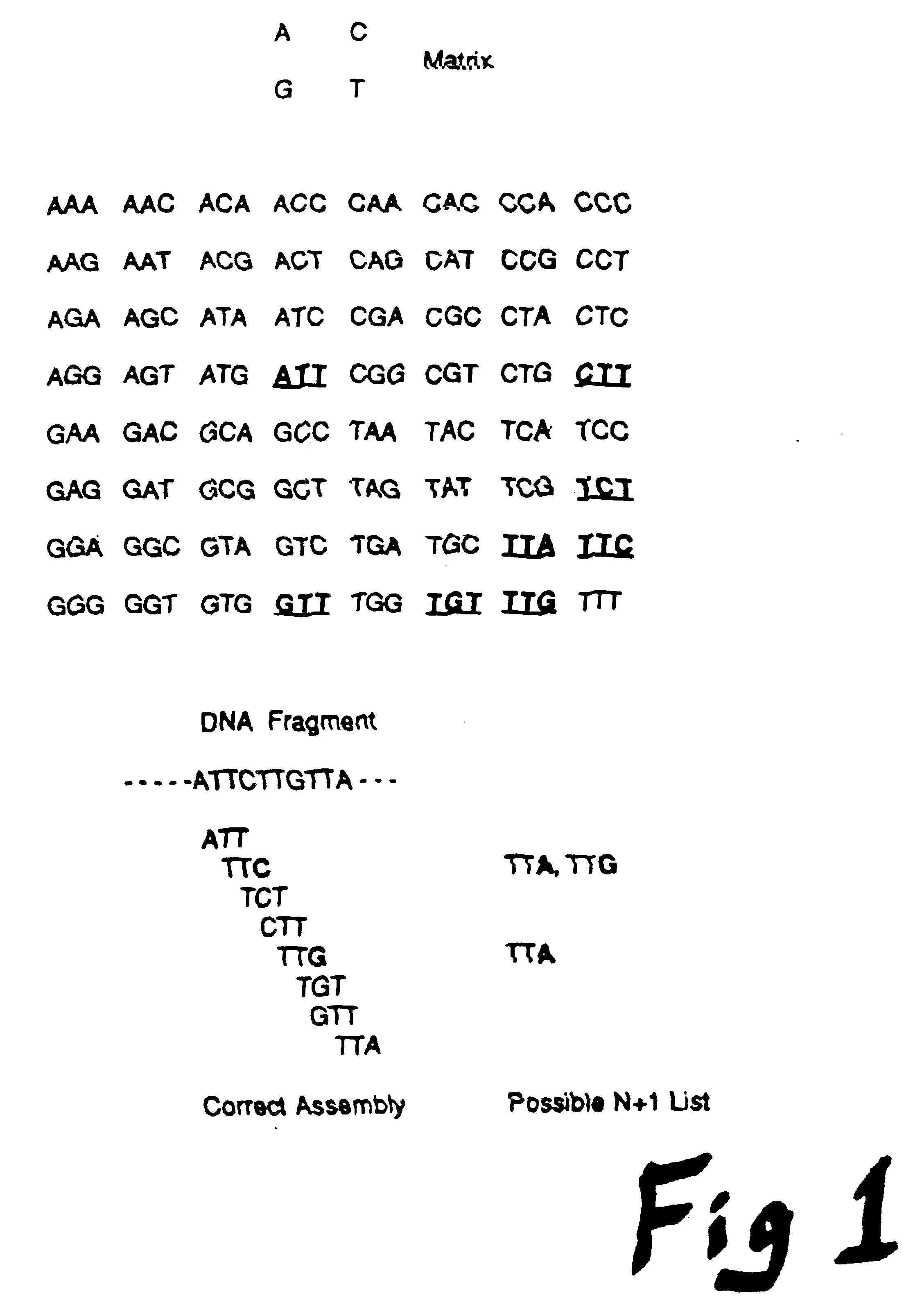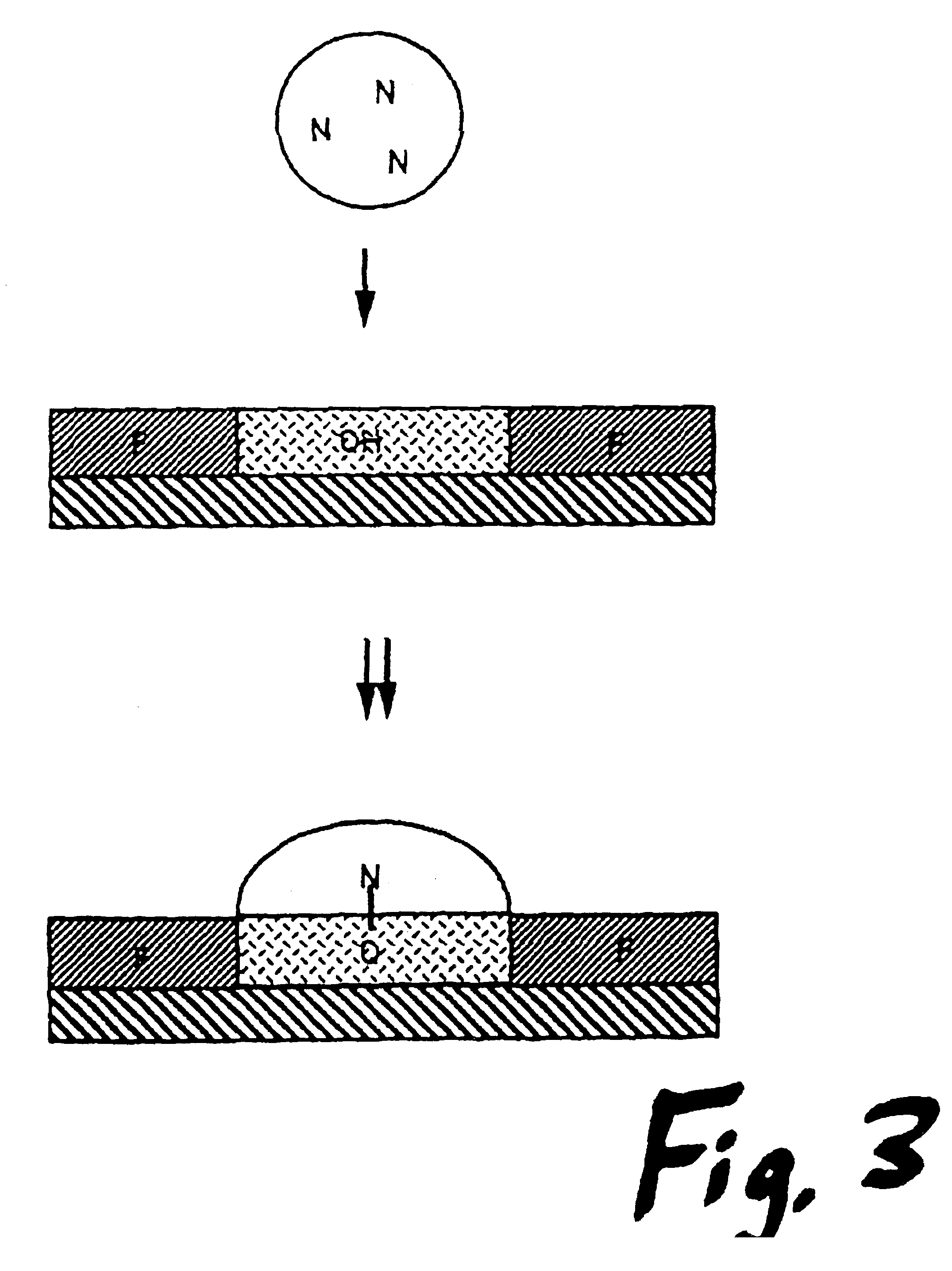Method and apparatus for conducting an array of chemical reactions on a support surface
a support surface and chemical reaction technology, applied in the field of methods, can solve the problems of limiting the speed at which ambitious sequencing projects can proceed, the method becomes unwieldy for the preparation of large arrays of oligonucleotides, and the density of arrays that may be produced by this method is limited, so as to achieve the effect of limiting the speed
- Summary
- Abstract
- Description
- Claims
- Application Information
AI Technical Summary
Benefits of technology
Problems solved by technology
Method used
Image
Examples
example 1
Preparation of Array Plates Ready for Oligonucleotide or Peptide Assembly
[0051]The hybridization array is synthesized on a glass plate. The plate is first coated with the stable fluorosiloxane 3-(1,1-dihydroperfluoroctyloxy)propyltriethoxysilane. An array of dots is then photoetched onto the coated surface using either an oxygen plasma or medium power CO2 laser to ablate off regions of the fluorosiloxane and expose the underlying silicon dioxide glass. The plate is then coated with glycidyloxypropyl trimethoxysilane, which reacts only on the exposed regions of the glass to form a glycidyl epoxide. The plate is next treated with hexaethyleneglycol and sulfuric acid to convert the glycidyl epoxide into a hydroxyalkyl group, which acts as a linker arm. The hydroxyalkyl group resembles the 5′-hydroxide of nucleotides and provides a stable anchor on which to initiate solid phase synthesis. The hydroxyalkyl linker arm provides an average distance of 3-4 nm between the oligonucleotide and ...
example 2
Assembly of Oligonucleotides on the Array Plates
[0052]The hydroxyalkylsiloxane surface in the dots has a surface tension of approximately γ=47, whereas the fluoroxysilane has a surface tension of γ=18. For oligonucleotide assembly, the solvent of choice is acetonitrile, which has a surface tension of γ=29. The hydroxyalkylsiloxane surface is thus completely wet by acetonitrile, while the fluorosiloxane masked surface between the dots is very poorly wet by acetonitrile. Droplets of oligonucleotide synthesis reagents in acetonitrile are applied to the dot surfaces and tend to bead up, as shown in FIG. 3. Mixing between adjacent dots is prevented by the very hydrophobic barrier of the mask. The contact angle for acetonitrile at the mask-dot interface is approximately θ=43°. The plate effectively acts as an array microtiter dish, wherein the individual wells are defined by surface tension rather than gravity. The volume of a 40 micron droplet is 33 picoliters. The maximum volume retaine...
example 3
Construction of Piezoelectric Impulse Jet Pump Apparatus
[0054]Piezoelectric impulse jets are fabricated from Photoceram (Corning Glass, Corning, N.Y.), a UV sensitive ceramic, using standard photolithographic techniques to produce the pump details. The ceramic is fired to convert it to a glassy state. The resulting blank is then etched by hydrogen fluoride, which acts faster in exposed then in nonexposed areas. After the cavity and nozzle details are lapped to the appropriate thickness in one plate, the completed chamber is formed by diffusion bonding a second (top) plate to the first plate. The nozzle face is lapped flat and surface treated, then the piezoelectric element is epoxied to the outside of the pumping chamber. When the piezoelectric element is energized it deforms the cavity much like a one-sided bellows, as shown in FIG. 5.
[0055]To determine the appropriate orifice size for accurate firing of acetonitrile droplets, a jet head with a series of decreasing orifice sizes is...
PUM
| Property | Measurement | Unit |
|---|---|---|
| diameter | aaaaa | aaaaa |
| temperatures | aaaaa | aaaaa |
| pore size | aaaaa | aaaaa |
Abstract
Description
Claims
Application Information
 Login to View More
Login to View More - R&D
- Intellectual Property
- Life Sciences
- Materials
- Tech Scout
- Unparalleled Data Quality
- Higher Quality Content
- 60% Fewer Hallucinations
Browse by: Latest US Patents, China's latest patents, Technical Efficacy Thesaurus, Application Domain, Technology Topic, Popular Technical Reports.
© 2025 PatSnap. All rights reserved.Legal|Privacy policy|Modern Slavery Act Transparency Statement|Sitemap|About US| Contact US: help@patsnap.com



